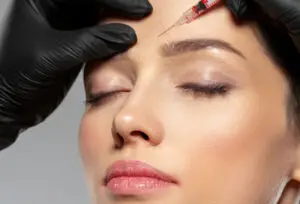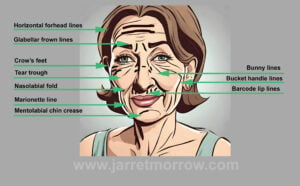Over the last decade, injectable dermal fillers have become a standard treatment to smooth fine lines, replenish lost facial volume, and create a more youthful appearance.
According to the International Society of Aesthetic Plastic Surgery databank, hyaluronic fillers were the second-most common nonsurgical aesthetic procedure in 2019, accounting for nearly 750,000 procedures¹ in the United States alone. At the same time, the range of products to choose from has expanded significantly with the advancement of gel manufacturing technologies.
Different dermal fillers can share the same purpose but comprise vastly different rheologic profiles and physicochemical properties. These properties can distinguish dermal fillers in functionally important ways, making them effective tools for clinicians to choose the best products for specific procedures. What this means in simpler terms, is that not all dermal fillers are equivalent—some have different properties which we will discuss that make one dermal filler better suited for under-eye bags vs another product that’s useful for volumizing your cheeks or enhancing your jawline.
With the growing popularity of aesthetic procedures, there’s a lot of information floating around dermal fillers—whether it’s from your friend who recently got an under-eye filler or that influencer you follow on Instagram—which can make it hard to separate fact from fiction. Here’s why dermal filler rheology is essential—and how it can affect the performance of your fillers.
Types of Dermal Fillers
There are several types of dermal fillers available, each with its own unique properties and rheologic profiles². Some of the most common types of commercial dermal fillers include:
Hyaluronic Acid Fillers
As one of the most common types of dermal filler, hyaluronic acid (HA) injections can help improve the skin’s contour and reduce the appearance of depressions in the skin. HA fillers are ideal for softening the nasolabial folds and marionette lines, acne scars, jawline contouring, volumizing hollow temples, treating dark under-eye circles referred to as tear troughs, adding volume and shape to lips, and more.
Hyaluronic acid is a naturally occurring substance in the human body, with high concentrations in the skin, eyes, and soft connective tissues. It’s the same substance that’s injected into arthritis-affected joints to provide extra cushioning and pain relief, and it’s also a popular ingredient in many skin care products. With aging, the skin loses HA which decreases its elasticity.
As a polysaccharide, HA is a type of sugar molecule. Natural HA is different than the types of HA in dermal filler products. Natural HA is broken down or degraded by your body in just a few days. HA in dermal fillers products uses cross-linking technology (to bind the polymers together). This slows down its degradation and by varying the amount of cross-linking, this can alter the amount of lift or hardness of the product itself.
Some types of HA fillers include:
- Juvederm® Volite, Volbella, Volift, Voluma, Volux, and Ultra Plus XC.
- Restylane® Refyne, Defyne, Lyft, Volyme, Skin Boosters, and Fine lines
- Revanesse® Kiss, Ultra, Contour, Versa, and Redexis
Although HA injections are often considered the “gold standard” of dermal fillers, the character of hyaluronic acids varies widely, making HA fillers the primary focus of studies on rheologic parameters. We’ll discuss more about this again shortly.
Calcium Hydroxylapatite Fillers – Radiesse
Similar to HA, calcium hydroxylapatite is naturally produced by the human body. It’s actually the main component or mineral that dental enamel is made out of. As a mineral-like compound found in human bones, it’s often used to treat nasolabial folds, temples, jawline, hands, and add fullness to the cheeks and other facial contours.
Calcium hydroxylapatite is biosynthetically produced, meaning that no animals or animal products are used during the manufacturing process. This can help lower your risk of an allergic reaction. These fillers produce natural results and don’t migrate to other areas of the face. With uses in dentistry and reconstructive surgery, calcium hydroxyapatite has a long safety record. Radiesse is considered a semi-permanent filler and is not reversible. It typically lasts a year or often longer.
Poly-L-lactic Acid Fillers – Sculptra®
Sculptra® is a synthetic filler that stimulates the body’s production of collagen. Poly-l-lactic acid is a non-toxic, biodegradable substance that has been used for over 40 years as a suture material.
As a stimulator, it’s best suited for dermal injections on the lower half of the face. In particular, many clinicians use Sculptra® to treat deep nasolabial folds, for jowls and chin enhancement as well as treating the temples. It should not be used to treat the lips or thinner skin like under the eyes.
Unlike other dermal fillers, Sculptra® doesn’t produce immediate results. Instead, it stimulates collagen production, with results appearing gradually the months following the procedure. As well, unlike HA fillers it is not reversible. Results can last as long as 24 months though multiple treatment sessions are required to achieve results.
Rumors abound that certain male celebrity A-lister action stars have used treatments with Sculptra® to defy aging in a naturally appearing way without looking puffy or bloated. It’s also gaining popularity for the Sculptura® butt lift.
The results of most dermal fillers are somewhat instantaneous, and most types of dermal fillers last approximately 6-12 months. At Serene Radiance Rutherford, we typically use dermal fillers in combination with neuromodulators, such as Botox and Dysport, to help our clients achieve their aesthetic goals, rejuvenate their skin, and enjoy long-lasting results.
What Is Dermal Filler Rheology?
In the field of plastic surgery and aesthetic medicine, many procedures use commercially procured filler materials, such as hyaluronic acid. For clinicians to achieve optimal results, they must carefully consider the rheologic profiles of different filler products—or the properties of fillers in terms of deformation and flow.
There are four main rheological parameters used to describe the viscoelastic properties of dermal fillers:
- G* (measures the “hardness” of the filler)
- G’ (measures the filler’s elastic properties)
- G” (measures the fillers’ viscous properties)
- tan δ (measures the ratio between the fillers’ viscous and elastic properties)
Viscoelasticity
We refer to the viscoelasticity of HA fillers. Fillers have elastic properties that allow them to bounce back to their original shape. As well, there is some viscosity or thickness to the flow of dermal fillers. A common analogy is honey which has a high viscosity, but low elasticity. There is some resistance in squeezing it out of a tube, but there is little elasticity to allow it to maintain its shape. HA fillers differ in that they have greater elasticity than viscosity.
G Prime
For most injectors, the first property that we talk about in regard to HA fillers is their G’ or “G Prime” as it’s called. G’ is roughly equivalent to G*, so it’s a reflection of how hard the filler is. Really though, it has to do with the elasticity of the filler. How much force can the filler resist and bounce back to its original shape after that force is removed?
Dermal fillers with a higher G’ have more lifting ability and tend to maintain their shape better. In contrast, fillers with a lower G’ will spread more. This is desirable for fine lines or under the eyes.
Cohesivity
Another important property of HA fillers is cohesivity which refers to how well the gel sticks together. Forces that test this property rely on stretching or compressing the gel. Fillers with a higher HA concentration have a greater degree of cohesivity, they also tend to cause more swelling.
Hydrophilicity
If you think back to your high school chemistry classes, hydrophilic refers to attracting water. HA fillers all vary in the degree to which they are hydrophilic. In general, products like Juvederm Ultra and Ultra plus which have higher HA concentrations (24mg/ml) are more hydrophilic. This results in more swelling, not surprisingly.
Why Does Dermal Filler Rheology Matter?
Commercial fillers exhibit a wide range of properties. In particular, dermal fillers differ in their chemical composition and longevity, with different types of fillers offering varying degrees of hardness, elasticity, viscosity, and cohesivity.
When dermal fillers are injected into the skin, they’re subjected to a complex interplay of forces—from shear stress to stretching forces—which cause deformation. Facial fillers must be implanted with consideration of the various dynamics and forces in each part of the face. A better understanding of rheologic characteristics, which help ensure optimal filler performance, can help clinicians enhance clinical results.
Essentially, choosing the right dermal filler rheology can help combat deformation, improve the longevity of your filler, and ensure your results match your expectations. To choose the best dermal fillers for your procedure and aesthetic goals, your clinician will carefully consider the rheologic profiles of different products.
Because clinical data on the performance of different dermal fillers are lacking, the practical experience of injectors provides a valuable source of knowledge regarding rheologic properties and product use. In other words, an experienced clinician will have the clinical knowledge and experience to choose a dermal filler product based on your unique skin quality, the degree of correction, the injection depth, and the anatomical location of your injection.
Factors That Impact Rheologic and Physicochemical Properties
The type and extent of crosslinking—together with the concentration of hyaluronic acid—primarily determine the rheologic and physicochemical properties of dermal fillers³. Several other factors can impact the rheologic profile of products, although often to a lesser extent. These factors include the substrate’s molecular weight and the process used to fragment the bulk hydrogel into a smaller, block-like injectable form.
Crosslinking determines the hydrogel’s mechanical strength and the filler’s longevity. Crosslinking involves introducing chemical linkages between the hyaluronic acid chains or stabilizing the enlargements that these chains form on their own.
The crosslinking process creates a block-like form of hydrogel, which is then fragmented into smaller pieces depending on the intended use of the final product. Hydrogels processed into smaller fragments are typically used for superficial injections. Meanwhile, hydrogels with larger fragments are better suited for deeper planes.
Many filler formulations, including hyaluronic acid fillers, rely on crosslinking reactions for improved rheologic properties. The degree of crosslinking can affect the cohesion of the filler, as well as other properties, including spreadability and moldability. During the manufacturing process, different hyaluronic acid substrates, concentrations, and crosslinking reactions may be used, creating unique rheologic profiles among different products.
How Do Rheologic Properties Affect Filler Function?
Dermal fillers are subjected to various forces throughout their life. They should be stable when stored and smooth enough to easily push through the tip of the needle. After injection, they should resist compression and shear forces to provide long-lasting results. Depending on the type of filler, different spreading and molding properties might be optimal.
For example, dermal fillers should have a low viscosity and be easy for your doctor to push through the needle. At the same time, the filler must maintain sufficient viscosity to stay in place once injected. A fine line filler should spread and easily mold within the tissue. On the other hand, fillers in the lower face—where there’s much more facial mobility—should be sturdier and more resistant to spreading.
In many cases, product differentiation is based on a rheolgic property known as elastic modulus (G’), although clinicians may consider other physicochemical properties when evaluating product performance. Research has shown that dermal fillers with higher G’ are better suited for thicker skin and deeper injection planes, while fillers with lower G’ are ideal for superficial planes.
Although some of these rheologic properties might seem at odds with each other, your clinician will target specific properties to choose the best option for you. Essentially, by targeting different rheologic properties—such as viscosity, yield stress, and elastic modulus—it’s possible to choose a dermal filler product that will provide the results you’re looking for.
Rheologic Applications for Dermal Filler Injection
The face is a dynamic structure. As we mentioned before, any dermal fillers injected into the face will experience complex combinations of shear and compression/stretching forces from both intrinsic and extrinsic sources⁵.
Intrinsic sources include motions and tensions between the bone and overlying muscle, fat, and skin. Meanwhile, extrinsic sources include shearing and stretching from day-to-day activities, such as eating, yawning, and kissing. To stand up to these forces, dermal fillers need different mechanical properties depending on their intended purpose and region of injection.
Midface Fillers
To restore a youthful appearance to the midface region, dermal fillers must provide projection, restore volume, and have three-dimensional contouring. As such, clinicians should select fillers that properly maintain their shape and projection.
These fillers must resist the face’s shearing and compression forces of the weight and tension of the overlying soft tissue, the dynamic contraction forces of the lip and cheek elevators, as well as the extrinsic forces mentioned above. In terms of their rheologic profile, these fillers need a sufficient elastic modulus to withstand shearing, along with medium cohesivity to resist compression forces.
Fine Line Fillers
For clients looking to smooth fine lines and minimize the appearance of wrinkles, dermal fillers with lower cohesivity are ideal. These fillers are easy to mold and spread within the tissue.
Combined with a medium elastic modulus, low-cohesivity fillers provide great non-bulking properties in superficial injection sites. In addition, these fillers are less prone to creating visible edges and bumps, offering a smooth, natural-looking appearance.
Lower Face Fillers
Because the lower facial region is subject to significant mobility—from nasolabial folds to accordion lines—clinicians must consider several rheologic parameters. Here, fillers are injected into the deep dermal or subdermal plane. Consequently, dermal fillers must be easily moldable, resistant to facial movement, and have minimal projection.
Since this region primarily experiences shearing and mild compression forces, fillers with a moderate elastic modulus and medium cohesivity are ideal. In more severe folds, fillers with high cohesivity may provide better correction but will be more difficult to mold.
Nose and Chin Fillers
To project the nose and chin, fillers must resist the high compression and shearing forces. In this region of the face, the main force is compression due to the skin and muscle tension over the bone structure. To extend the lifetime of the injection and minimize spreading, clinicians should opt for dermal fillers with higher cohesivity and a high elastic modulus. Restylane Lyft® is a popular choice for non-surgical rhinoplasty.
How To Choose the Right Dermal Fillers
Because rheologic properties can vary significantly between different filler products, it’s essential to work with an experienced clinician who can choose the right filler for you. Ultimately, clinical experience with dermal fillers allows clinicians to gain a better understanding of how different rheologic profiles affect the performance and functionality of dermal fillers.
When you work with an experienced clinician, you’ll be able to discuss your goals and expectations and establish a personalized treatment plan to achieve your skincare goals. Your doctor will take the time to choose the right dermal fillers for your skin and your specific procedure so you enjoy the optimal aesthetic outcome.
When you’re ready to rejuvenate your skin with dermal fillers, reach out to Dr. Morrow. With over seven years of experience in cosmetic injectables, Dr. Morrow offers professional dermal fillers, lip fillers, tear trough fillers, and other high-quality cosmetic treatments to help you bring your skincare dreams to life.
Contact us today to discuss your treatment options for radiant, youthful skin.
References:
- Statistics. The Aesthetic Society.
- Dermal Filler. American Society of Plastic Surgeons.
- Fagien S, Bertucci V, von Grote E, Mashburn JH. Rheologic and Physicochemical Properties Used to Differentiate Injectable Hyaluronic Acid Filler Products. Plast Reconstr Surg. 2019 Apr;143(4):707e-720e. doi: 10.1097/PRS.0000000000005429. PMID: 30921116; PMCID: PMC7597953.
- Pierre, Sébastien PhD*; Liew, Steven MD†; Bernardin, Aude PhD* Basics of Dermal Filler Rheology, Dermatologic Surgery: April 2015 – Volume 41 – Issue – p S120-S126. doi: 10.1097/DSS.0000000000000334.
- Choi MS. Basic rheology of dermal filler. Arch Plast Surg. 2020 Jul;47(4):301-304. doi: 10.5999/aps.2020.00731. Epub 2020 Jul 15. PMID: 32718107; PMCID: PMC7398800.






